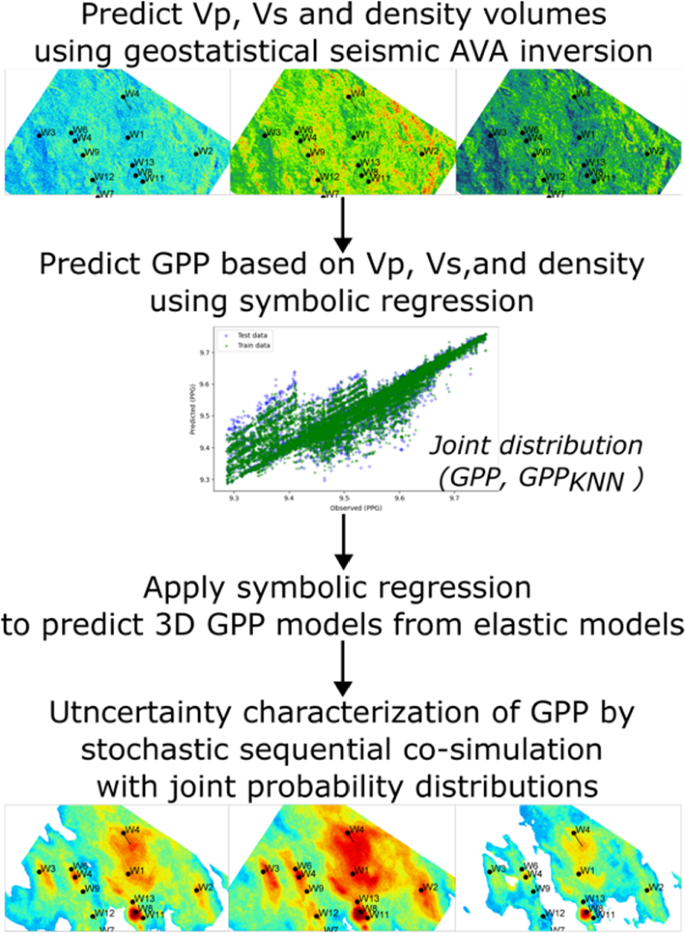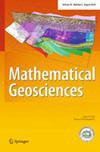孔隙压力不确定性表征耦合机器学习和地质统计建模
IF 3.6
3区 地球科学
Q2 GEOSCIENCES, MULTIDISCIPLINARY
引用次数: 0
摘要
摘要孔隙压力预测是深部复杂储层钻井的基础。即使在特征相对较好、钻井数量较多的油气藏中,当处于具有挑战性的地质环境时,异常孔隙压力预测不佳可能导致灾难性事件,对人类生命和基础设施造成危害。为了更好地量化钻井风险,与孔隙压力预测相关的不确定性应整合到地质建模工作流程中。利用巴西盐下油藏具有挑战性的真实案例,本文提出了一种地震驱动的梯度孔隙压力建模工作流程,该工作将机器学习和地质统计学联合模拟相结合,以预测高分辨率梯度孔隙压力体积。首先,对现有的角度相关地震反射数据进行了纵波和横波速度和密度反演。然后,根据测井信息,利用k近邻法建立孔隙压力梯度与纵、横波速度、密度、深度之间的回归模型;将训练好的模型应用于地统计地震反演模型的三维梯度孔隙压力模型的预测。该梯度孔隙压力模型是高度可变的地下的光滑表示,并作为二次变量与联合概率分布进行随机序列联合模拟,生成多个高分辨率的梯度孔隙压力实现。联合模拟模型的集合可以用来评估梯度孔隙压力预测的空间不确定性。应用实例的结果表明,该方法能够再现地震资料中观测到的空间模式,并再现两个盲井位置的现有梯度孔隙压力测井曲线,这些测井曲线不用于梯度孔隙压力预测。本文章由计算机程序翻译,如有差异,请以英文原文为准。

Pore Pressure Uncertainty Characterization Coupling Machine Learning and Geostatistical Modelling
Abstract Pore pressure prediction is fundamental when drilling deep and geologically complex reservoirs. Even in relatively well-characterized hydrocarbon reservoir fields, with a considerable number of drilled wells, when located in challenging geological environments, poor prediction of abnormal pore pressure might result in catastrophic events that can cause harm to human lives and infrastructures. To better quantify drilling risks, the uncertainty associated with the pore pressure prediction should be integrated within the geo-modelling workflow. Leveraging a challenging real case from the Brazilian pre-salt, the work presented herein proposes a seismic-driven gradient pore pressure modelling workflow, which combines machine learning and geostatistical co-simulation to predict high-resolution gradient pore pressure volumes. First, existing angle-dependent seismic reflection data are inverted for P- and S-wave velocity and density. Then, K-nearest neighbor is used to create a regression model between pore pressure gradient and P- and S-wave velocity, density and depth based on the well log information. The trained model is applied to predict a three-dimensional gradient pore pressure model from the models obtained from geostatistical seismic inversion. This gradient pore pressure model is a smooth representation of the highly variable subsurface and is used as secondary variable in stochastic sequential co-simulation with joint probability distributions to generate multiple high-resolution realizations of gradient pore pressure. The ensemble of co-simulated models can be used to assess the spatial uncertainty about the gradient pore pressure predictions. The results of the application example show the ability of the method to reproduce the spatial patterns observed in the seismic data and to reproduce existing gradient pore pressure well logs at two blind well locations, which were not used to condition the gradient pore pressure predictions.
求助全文
通过发布文献求助,成功后即可免费获取论文全文。
去求助
来源期刊

Mathematical Geosciences
地学-地球科学综合
CiteScore
5.30
自引率
15.40%
发文量
50
审稿时长
>12 weeks
期刊介绍:
Mathematical Geosciences (formerly Mathematical Geology) publishes original, high-quality, interdisciplinary papers in geomathematics focusing on quantitative methods and studies of the Earth, its natural resources and the environment. This international publication is the official journal of the IAMG. Mathematical Geosciences is an essential reference for researchers and practitioners of geomathematics who develop and apply quantitative models to earth science and geo-engineering problems.
 求助内容:
求助内容: 应助结果提醒方式:
应助结果提醒方式:


